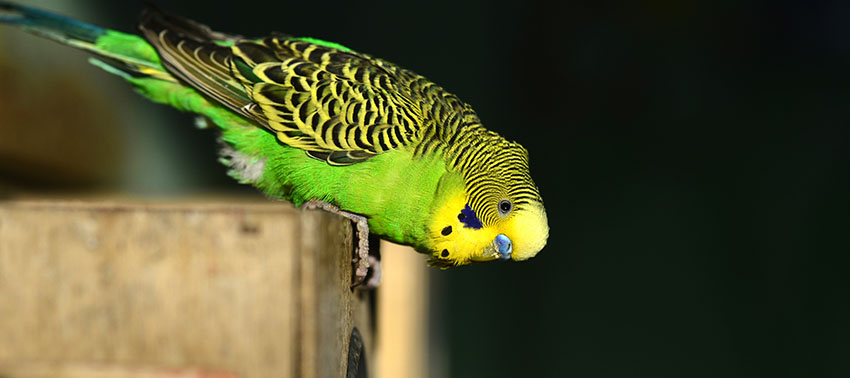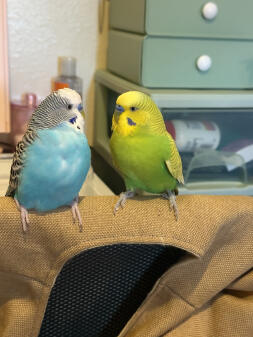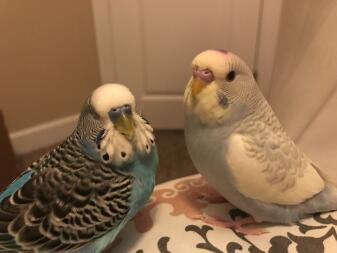If everything is ok, and nothing is ailing your bird, then they will display the following “typical” behavior.
Parakeet Wing Stretching
Just like any other animal, parakeets need to take a good stretch after an extended period of inactivity. It’s a good time to admire your bird's beautiful wing feathers, as he ill stretch his leg and wing on one side, then the other. Both wings are then raised to finish off the exercise and get the blood flowing to the muscles. This will be done in silence and should not be confused with the often noisy and aggressive wing-raising behaviour often seen at a crowded food bowl.

Parakeets need to stretch their wings
Parakeet Head Bobbing
Male parakeets enjoy “head bobbing”, and watching them in action is very entertaining. This fast and fluid up-and-down motion of the bird’s neck is often accompanied by chattering. If your male bird is lucky enough to have a female companion, he will often display his rubber neck for her benefit, as this action is a part of his mating display. If everything goes to plan, this head bobbing will be followed up by mutual feeding and eventually mating.
Domestic birds will also bob their heads at other times too. An outgoing bird will tend to bob his head more than a quieter bird. Females may also partake in this head bobbing, but it is mostly males who indulge in the habit. They will bob to other males, toys, mirrors and even you. Head-bobbing usually indicates that your bird is happy and excited.

Head-bobbing is part of a parakeet's body language
If you show your appreciation of head-bobbing to a tame bird, he will get into the habit of doing it more often. Whilst its impossible to tell what’s going through a parakeets mind, head bobbing is always an indicator that he’s feeling good.
Baby parakeets will also often head-bob, but for different reasons. Usually to show that they’re hungry. Once weaned and perching with the adult birds, young parakeets often cling to their parents in this way for as long as they can, head-bobbing for food. When this is paired with a chirrup that means “feed me!”, the action usually gets results. Yet there will come a time when the parents lose interest and the chicks will have to fight their way to the food tray just like everyone else.
Parakeet Exercise
Parakeet Chewing
First thing in the morning, parakeets will often flap their wings violently as they perch. Sometimes their feet will leave the perch and they’ll perform a somewhat noisy hover. This is to warm up their muscles and has nothing to do with display or aggression - they simply need to shake their wings after a long period of rest. This mad flapping will often be accompanied with calls and chirrups..Note: Parakeets need to exercise their wings a lot more than this, and if you’re keeping them in a cage with little room for flight, you will need to let them out so that they can fly around the room outside their cage.
Parakeets also seem to enjoy gymnastics and can often be seen climbing the sides and the roof of their cage.
Parakeet Playing With Toys
Your parakeet will take an interest to anything you place in his cage, getting his beak into all its corners and nibbling its edges. Some birds are more timid than others and will have to work up the courage to check out the new item, this can sometimes take hours or even days, it all depends on the bird. Once the bird has fully checked out the item and played with it for a few days they will start to lose interest. It’s therefore important to replace old toys with new ones on a rotational basis.

Parakeets enjoy lots of toys
Anything that hangs from the roof of the cage and moves around or makes a sound will bring your birds hours of exercise and amusement,as will something that rolls. Many birds will take a liking to ping-pong balls, nudging them across the floor with their beaks. A toy with a reflective surface may also sometimes trigger a mating response from a bird, especially if he lives alone in his cage. If your bird begins regurgitating seed to a toy, it’s best to remove the toy and let his attention focus elsewhere.
Parakeet Obsessed With Bell
Parakeets, especially lone birds, become very attached to their toys. A bell, being an item that moves and makes a noise, is very often a favourite. Tapping and ringing the bell can very easily become a part of your bird's routine, and sometimes it can start to verge on obsessive behavior. This is a sign that the parakeet needs companions. Completely removing the bell may initially have a negative effect on your bird's happiness, but parakeets are very adaptable and clever birds and he will soon shift his attention to other areas of the cage. But again, the best way to wean your bird off the bell is to introduce a companion into his cage.

Parakeets love their bells
Parakeet Eye Pinning
A favorite toy, or an exciting new one may trigger something called “eye pinning” (sometimes known as eye flashing). This is when the parakeets pupils dilate and contact rhythmically as he focuses on this interesting object. Pupils also dilate when a cock bird is about to regurgitate to his mate or best friend..
Another sign that your parakeet is engaged and curious is when they tilt their head to one side to get a good view of whatever he’s looking at.
Parakeet Scratching
Parakeets also love to chew things -- it’s a natural instinct that they will seek to satisfy one way or another, so it’s best to provide them with something that they can take out this urge on. Balsa wood is ideal, as is a wooden perch or stick. Cuttlefish bone doesn’t count as “chewable”, as it crumbles to powder as the bird pecks.

Parakeets need something to chew on
Parakeet Yawning
Just like us, parakeets yawn when they’re tired. Their beaks open wide, the eyes close, and the neck stretches out. Sometimes the bird will do this several times. You don’t have to worry about this, it’s just a precursor to sleeping. However, if the parakeets beak stays open for an abnormally long amount of time, or if he shakes his head or makes coughing sounds , then you should be concerned. This indicates a problem, possibly a blockage of some type, and you should take him to the vet as soon as possible.
Funnily enough, parakeet yawns can be just as contagious as human yawns, and you might even find yourself joining in with your bird and pondering on this rather odd cross-species phenomenon.
Parakeet Behaviour in Pairs
Parakeets are social birds and will, usually, enjoy the company of each other. A pair of birds will generally act as a self-contained miniature flock, enjoying all the grooming, chattering and socialising natural to their species in the wild
Although it is very uncommon, it’s not unheard of for two parakeets to not get along. They may fight, or just stay on opposite sides of the cage and not talk to each other. If this is the case then there will be no mutual grooming, and they will not sit and chatter with each other. In situations like these, the birds should be separated. Sometimes a mirror can help break the ice - the birds will interact with the “newcomer”, and this may shift the social balance of the flock sufficiently for them to become more friendly.
A pair of birds that get along well will display to each other. The cock will sing his best songs and bob his head, and may even offer a delicious meal of regurgitated seed. The pair will touch their beaks together too, and often preen each other on the face and head. The two will tend to stay close, often side by side on a perch.
<
Two’s company for these white spangle parakeets
Parakeet Bonding Behaviour
The moment a parakeet moves from its nest to a perch, it is officially a part of the flock, and its behavior will be all about bonding. It will quickly merge its life with the rest of the flock, eating, grooming, chattering, flying and washing with all the other birds. Parakeets bond by doing certain activities together. When two birds become good friends, they will tap their beaks together in a sort of “parakeet kiss”, and will often preen each other’s faces and head.
If you opt for just one bird, then you will have to take up the role of the parakeets flock and provide them with social stimulation. This includes talking to the bird, bringing them out of the cage and allowing them to sit with/on you as you walk, talk, eat, watch TV, etc. When this is done with the time and dedication it demands, you will have one very happy bird, and will have formed a deep bond with it. Friendship with a tame parakeet can be every bit as satisfying as time spent with a well-trained pet dog.
Parakeet Preening or Grooming
Preening is the parakeets equivalent of a shower, helping them stay clean and well-groomed. Two birds will often do a little grooming of each other, usually the head and chin areas that a bird can’t reach on its own. Like many other birds, parakeets have a feather-oil gland at the base of their tail, and preening consists of them taking this oil onto their beak and running it down each feather, starting where the feather attaches to the skin. Each feather needs the full treatment, so a preen takes a long time. Parakeets tend to do this activity together - like most other things, they seem to work best when carried out as a flock activity.

A parakeet preening
Preening usually finishes with the bird puffing up and shaking everything into place with one, violent shudder. The tail is then swiftly wagged, to add the finishing touches to the preening session.
Parakeet Mutual Preening
As mentioned before, a parakeet can not preen its own face and head. They can scratch them with their foot, but nothing beats having a partner do it for them. Pair, or any gender combination, will oblige by grooming these out-of-reach places. If your bird lives alone and is finger trained, you can give them the next best thing by scratching their head with a finger. If he fluffs up his head and closes his eyes, then you’re doing it well. If he keeps his feathers tight and nibbles at your finger, you haven’t got the magic touch that they seek.





















Comments
Leca, 4 September 2025
I have four keys, they fly around me all the time. So I always make sure to come close to them and carry a conversation. Listening to my voice, eyes tend to close and just enjoy my company.
Budgie, 12 July 2024
The stretching wing and leg thing when you walk in the room is literally just that, a stretch because you walked into the room. It’s not coincidence, but it’s not quite a greeting. They associate your presence/the cover being lifted etc with some form of activity and if they have been resting or it’s first thing in the morning, they’re stretching in preparation for the activity such as flying to the food for breakfast, getting out of the cage for a bit, maybe doing some training/playing if you do that sort of thing with them. Nothing fancy or complicated going on, just imagine you’ve been sitting for a while then someone says you’re going to do some moving about and you need a good stretch when you stand up. It’s just like that.
Cody, 20 May 2023
We have two male Australian buggies. Every time we go to their cage or walk in the house as there cage is near the door, even when take the cover off from over night. They will put one wing out and stand on one foot and bow head their head as if they’re are greeting us. We have read about wing stretches, which they certainly do and the local bird “expert”at the pet said, they must be stretching and just be good timing each time you see this. This just seems to happen to offend at the same times. It’s literally like they are saying hello. We have are other buggie owners, I’ve even filmed it to show people. No seems to know. Is there anyone that knows about this behaviour or is it a case of them just greeting us?
Smith, 4 October 2021
I have a budgie mostly white and not albino who will sit on the one and one half...2 inches around round yellow plastic dish I put wet food in including egg yolk in it....and wiggle its bum on it with its wi gs away from its body. Is this bird exhibiting a female or male behaviour and what is this budgie doing. Second quesyion I am trying to sort which is female and which male. I have been observing who kisses who and who will not kiss who to discern this. Is their kissing together relevant to what sex they are. Was trying to do a deduction knowing one set that is a pair. The rest are still swinging partners but very happy.
Christi, 17 May 2021
Hello I bought to parakeet babies. Their stripes come all the way down to the beak and I read that means they’re younger than 4 mo. I started working with hand taming from day one I kept them out of their cage as much as possible and was able to hand feed them from day one. I do this daily but it seems as soon as they loose interest in eating they fly away and I only can get them to land on me with a treat in hand. I’ve had them only one week. Will they grow to love me and come to me without treats and only to eat?